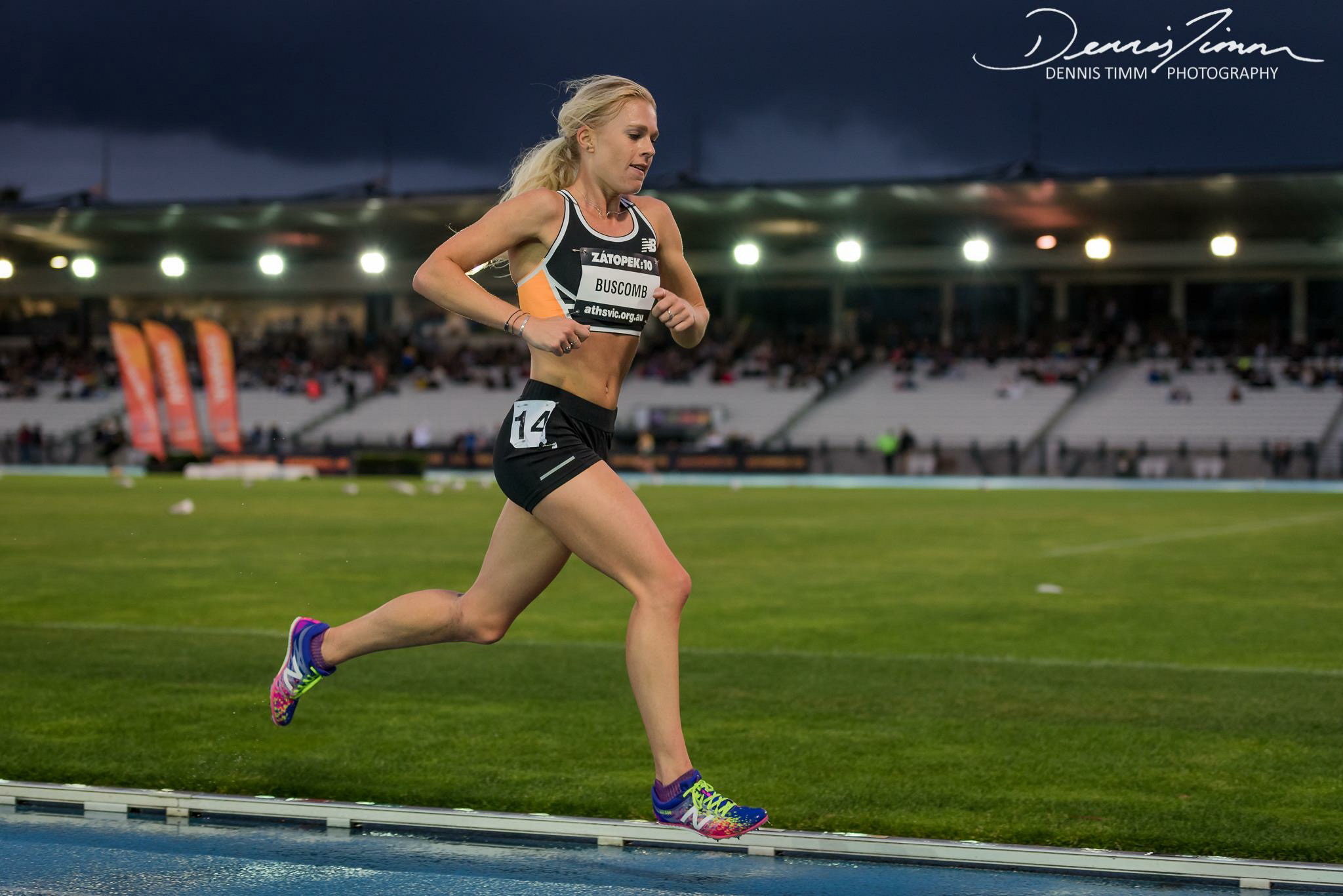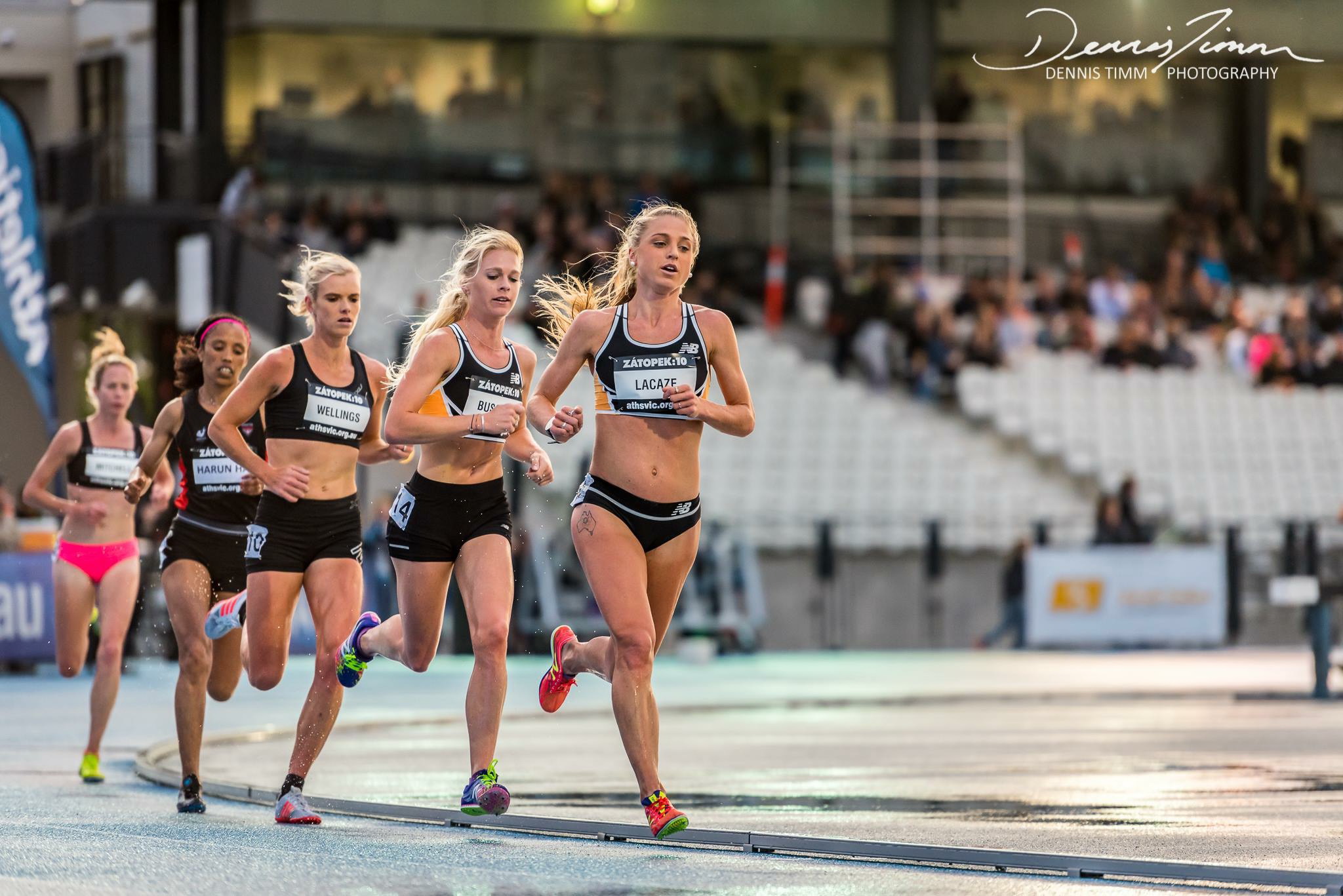© Copyright – 2016 – Athletics Illustrated

Camille Buscomb of Hamilton, New Zealand won the Zatopek 10 race in Melbourne on Thursday, December 8th. She defeated defending champion and pre-race favourite Eloise Wellings. Buscomb finished in the time of 32:34.41. The second place finisher was Australian Bridey Delaney who recorded a 33:04.72 result, while the third place finisher was fellow Aussie Makda Harun Haji, who crossed the line in 33:05.73.
Wellings is one of four women to have won the historic event three times, she was hoping to become the winningest runner all-time at Zatopek, but it was not to be.
It was the first win at Zatopek for a New Zealand runner in 10 years.
Buscomb is a distance specialist who is now focussing on the 5,000 and 10,000-metre events. She recently started training under the direction of the legendary coach Nic Bideau, who is known for managing or coaching Olympians Cathy Freeman, Craig Mottram and Sonia O’Sullivan to name a few.
Buscomb missed out on the Rio Olympic qualification standards due to lingering illness, however, now has as a renewed appetite to compete.
Personal bests
1500m – 4:13.80
3,000m – 9:05.24
5,000m – 15:28.78
10,000m – 32:26.36
Christopher Kelsall: Hamilton seems to have a perfect climate for training in – never too hot or too cool. There are some great runners that are from there including Dick Quax. Were you motivated into running from some of the rich history?
Camille Buscomb: I actually grew up in Cambridge, which is close to Hamilton. I remember going to athletics when I was five and running in the really little distances in bare feet on the grass track there. Cambridge has had some very successful sportspeople and I looked up to the likes of Sarah Ulmer and Rob and Sonya Waddell. I now live in Hamilton and I really love it here. The training is great along the river and has a great rubber track and there are hills close by and an easy distance away. I am definitely still motivated by the history of Hamilton. Our track is called Porritt Stadium and the roads around the track are named after famous athletes such as Snell, Lydiard, Halberg and Magee.
CK: Was the family active, growing up, any other runners in the family?
CB: Yes, my family is really active. My parents have both run the Rotorua Marathon a few times in the last few years – although they didn’t run themselves when they were younger. My Aunties on my Mum’s side have both raced in a few half marathons and my nana also has raced in a few half marathons, so I think that’s where my running has come from.
 CK: How would you describe your time at Purdue?
CK: How would you describe your time at Purdue?
CB: It was a really great time in my life. I was young and eager to experience the world. I was so excited to live away from family and New Zealand and experience life on my own. I had some wonderful experiences at Purdue. I really grew a lot as a person and discovered who I was and what I really believed in. It was also the place that made me really realise that running was my passion and that I really wanted to achieve my goals of representing New Zealand at the Commonwealth and Olympic Games. For that I am forever thankful to Purdue.
CK: After missing the Rio Olympic standards in the 5,000 and 10,000-metres due to lingering health issues, do you feel a small sense of redemption taking the Zatopek 10 – some big names have won there in the past.
CB: I am feeling really positive about my race at the Zatopek 10. This year has been honestly one of the hardest for me, with ongoing health problems and missing out on Rio after being so close. I have learned a huge amount this year, and I think that will set me up well for my running career ahead. Zatopek was great in the sense it showed that I am doing the right things and I am excited to be heading into 2017 with a positive mindset and a healthy body.
CK: What is it going to take to get at least the NZ B-standard for the 2017 world championships?
CB: I am actually unsure of what the B standard for Worlds will be. My goal for 2017 is to get in the 31-minutes bracket for the 10K so hopefully that time will get me there. I have another training block in January and will continue to build from where I am now. I am unsure when my next track 10K will be, but with a few more consistent months of training, and training camps I really think that I can give sub-32 minutes a good crack.
CK: Will you be competing in world cross in Uganda in March?
CB: I am really not a cross-country runner. My aim for 2017 will be to qualify for the World Champs in August in the 5,000m and 10,000m events on the track. So no, I won’t be targeting world cross.
CK: What are your thoughts on Athletics New Zealand making the Rio Olympic standards tougher than the IAAF standards? Do you feel there is sufficient depth to warrant the more difficult times to reach for?
CB: Honestly, I think NZ should keep with the IAAF standards. The IAAF set the standards for a reason and I don’t understand why a country of our small size would want to make it more difficult for its athletes to qualify for Olympics, Commonwealth Games etc. In 2014 I ran under the IAAF 5,000m standard seven times, but it wasn’t the NZ standard. It was really unfair watching girls I had raced and had beaten get to compete at the Games. It really doesn’t make sense as to why they do it. It stunts the growth of athletics in New Zealand and can be quite detrimental as a result. Making teams also increases the oppo rtunity for athletes to receive funding, and by making standards harder, ultimately many athletes have to withdraw from the sport because of lack of financial aid. A vicious cycle, but hopefully in years to come NZ will change their policies.
rtunity for athletes to receive funding, and by making standards harder, ultimately many athletes have to withdraw from the sport because of lack of financial aid. A vicious cycle, but hopefully in years to come NZ will change their policies.
CK: How is the appeals process? Say for example, you are the only one from NZ to hit the IAAF standard, do you have a sense that you could appeal to Athletics NZ for inclusion?
CB: I didn’t actually know that you could appeal until this year, so I think if I was to be in the same position again I would at least try to appeal. It really depends on the numbers in the event who have qualified from around the world and if they have met the target numbers then it may not be that I made the cut, but it honestly depends. Here’s hoping I can make the standard this year.
CK: You mentioned that your time at Purdue demonstrated that running is your passion. What other sports did you play growing up in Cambridge?
CB: I was involved in a wide range of sports including netball, basketball, tennis, swimming, touch rugby, and jazz ballet. I have always had a lot of energy and a competitive side, so sport was a really big favourite of mine. I would always play sport before and after school and on lunch and morning tea breaks.
CK: Rumour has it that you have a high capacity for training. What sort of weekly mileage volume do you get in during your off-season training weeks?
CB: Yes, I really like to train hard. I like to run decent weekly mileage but it honestly depends. I think at the moment I am sitting around 130-140km per week. I would like to do more, but you have to balance gym, circuits, and sessions into that so you don’t want to overdo it.
CK: What does a typical training week look like for you, off-season versus leading up to a competition schedule?
CB: I have actually just had a coaching change so I am unsure about what my race/competition training will be like. I have been with Nic (Bideau) for about three weeks now, so sessions Tues, Thurs, Sat, and a decent long run is what I am doing at the moment. Double days session days and some easy day plus three times gym/circuits.
CK: Regarding Zatopek 10, can you take me through the race?
CB: The race was set up for Eloise (Wellings). The aim was to have her run a low 32-minute 10,000m and win the national Australian title so that she could guarantee World Champs selection. Zoe (Buckman) and Gen (LaCaze) were to pace through the 5K in 16-minutes and she was to go it alone after that. I was to sit in and hang on. The weather was unfortunately not in our favour on the night as it was really windy and raining which was not ideal for fast times. The track was wet, and it was cold and it was windy. The girls pacing did a great job, I sat behind Gen and at about the 4K mark it was just me and her, and unfortunately, Eloise had dropped off the pace. Gen took me through the 5K in a tick over 16-minutes, but I was alone for the second half of the race. The pace slowed, but I felt strong and was really happy to finish in a decent time and feeling good, and was especially excited to get the win.
CK: What do you feel was the difference between you finishing second last year to Wellings and taking the race this year? Is it a fitness thing or tactics?
CB: It really is hard to say. I have to say that my build-up this year was a lot better and more consistent, but Eloise didn’t have such a good race this year and has come back from Rio where she was really peaking. I think it was really a combination of factors; more things in my favour, and not so much in hers perhaps.
CK: What are your goal races for 2017, I assume you will be chasing standards throughout to attempt to qualify for London, yes? Which races are you going to compete in?
CB: I am targeting qualification times for both the 5,000m and 10,000m events for London 2017. Honestly, I don’t
have a detailed race schedule yet, but I am focussing on races in April/May/June in America and Europe, but the exact races are not yet set in stone.
CK: What are your goals for the next few months?
CB: I am looking forward to the upcoming months of solid base training and my second stint at Falls Creek /altitude training, as I gear up for my American and European racing season. The training I am doing under Nic and the girls who I am training with will really set me up well to hopefully achieve my goals for running under the 15:22 and 32:15 time standards for World Champs.














